You’re about to discover extraordinary begonias that transform ordinary houseplant collections into stunning indoor gardens. From the hypnotic spiral patterns of the Escargot Begonia to the metallic sheen of the Rex varieties, these plants offer more than just standard foliage. Their leaves showcase nature’s artistry through intricate designs, bold textures, and unexpected color combinations that you won’t find in typical houseplants.
Contents
- 1 1. Escargot Begonia’s Spiral Leaves
- 2 2. Angel Wing Begonia
- 3 3. Rex Begonia’s Metallic Leaves
- 4 4. Iron Cross Begonia
- 5 5. River Begonia’s Silver Swirls
- 6 6. Begonia ‘Fireworks’
- 7 7. Begonia Lucerna
- 8 8. Beefsteak Begonia’s Red Underside
- 9 9. Begonia Soli-Mutata
- 10 10. Begonia Bowerae
- 11 11. Star Leaf Begonia
- 12 12. Maple-Leaf Begonia’s Autumn Colors
- 13 13. Begonia Venosa
- 14 14. Begonia Dregei
- 15 15. Begonia ‘Marmaduke’
1. Escargot Begonia’s Spiral Leaves
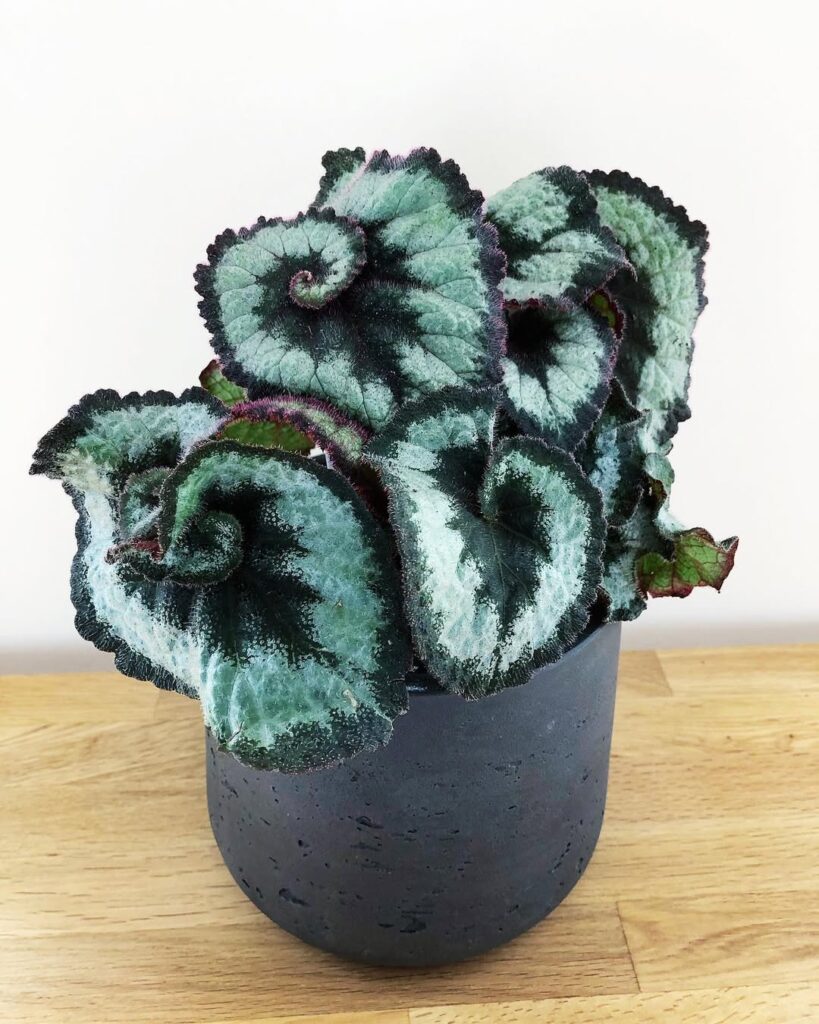
The Escargot Begonia (Begonia rex ‘Escargot’) is a striking variety known for its distinctive spiral pattern that resembles a snail’s shell, hence its name. Each leaf emerges from the center in a whorl, creating a hypnotic coil effect with bands of silver, deep green, and burgundy colors. The leaves grow in a circular pattern, with pronounced veining that follows the spiral, making it one of the most unique and decorative begonia varieties available.
- Light: Bright indirect light; protect from direct sun to prevent leaf burn
- Water: Keep soil consistently moist but not waterlogged; water when top inch of soil feels dry
- Soil: Well-draining, rich potting mix with high organic matter content
- Humidity: High humidity (60-80%); use pebble trays or humidifiers
- Temperature: 65-75°F (18-24°C)
- Fertilizer: Feed monthly during growing season with balanced liquid fertilizer
- Container: Pot with drainage holes to prevent root rot
- Growing Location: Indoor plant in most climates; suitable for USDA zones 10-11 if grown outdoors
2. Angel Wing Begonia
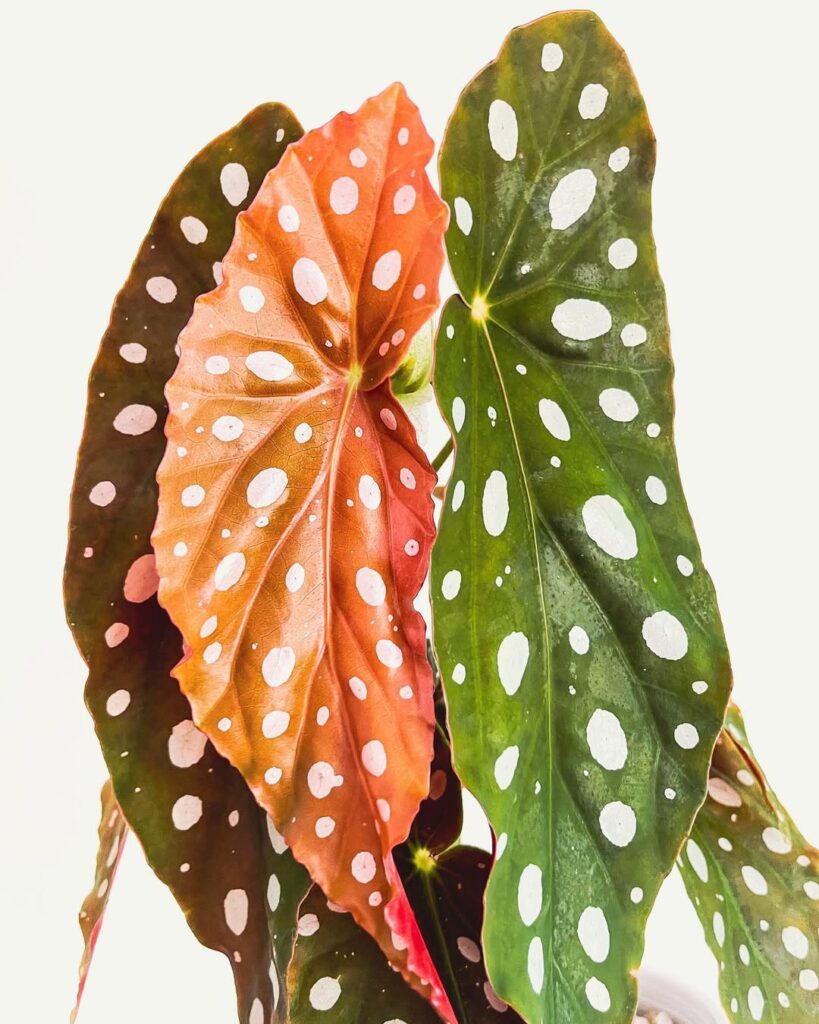
Angel Wing Begonia is a cane-type begonia known for its distinctive wing-shaped leaves featuring silver speckles or spots on dark green foliage. These elegant plants can grow quite tall, reaching heights of 2-4 feet indoors, and produce clusters of pink, red, or white flowers that dangle beneath the leaves. The leaves are asymmetrical with one side longer than the other, creating their characteristic angel wing appearance, and their stems grow in an upright, bamboo-like fashion.
- Light: Bright, indirect light; protect from direct sun except for gentle morning light
- Water: Keep soil consistently moist but not waterlogged; water when top inch of soil feels dry
- Humidity: High humidity (50% or higher); benefits from regular misting or humidity tray
- Temperature: 60-75°F (15-24°C); protect from cold drafts
- Soil: Well-draining, rich potting mix with added perlite
- Fertilizer: Feed monthly during growing season with balanced, water-soluble fertilizer
- Container: Pot with drainage holes to prevent root rot
- Pruning: Regular pinching and pruning to maintain shape and encourage bushiness
3. Rex Begonia’s Metallic Leaves
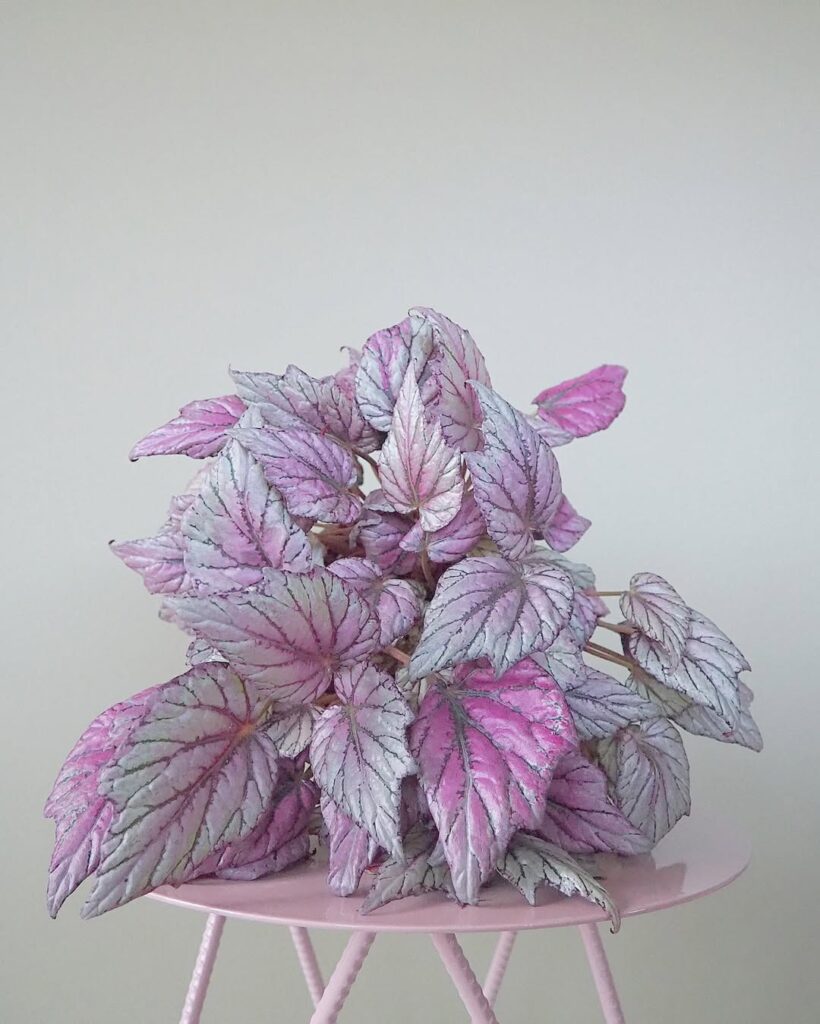
Rex Begonias are prized for their striking metallic-looking foliage, which can display iridescent silver, purple, and copper tones that seem to shimmer in the light. These ornamental leaves feature intricate patterns with swirling shapes and bold contrasting colors, often with deep green or burgundy backgrounds that make the metallic highlights appear even more dramatic. The leaves can grow quite large and are typically asymmetrical, with a distinctive spiral pattern emerging from the center of the plant.
- Light: Bright, indirect light; avoid direct sunlight which can fade the metallic sheen
- Water: Keep soil consistently moist but not waterlogged; water when top inch of soil feels dry
- Soil: Well-draining, rich potting mix with high organic matter content
- Humidity: High humidity (50-60%); use pebble trays or humidifiers
- Temperature: 60-75°F (15-24°C)
- Fertilizer: Feed monthly during growing season with balanced liquid fertilizer
- Soil pH: Slightly acidic to neutral (6.0-7.0)
4. Iron Cross Begonia
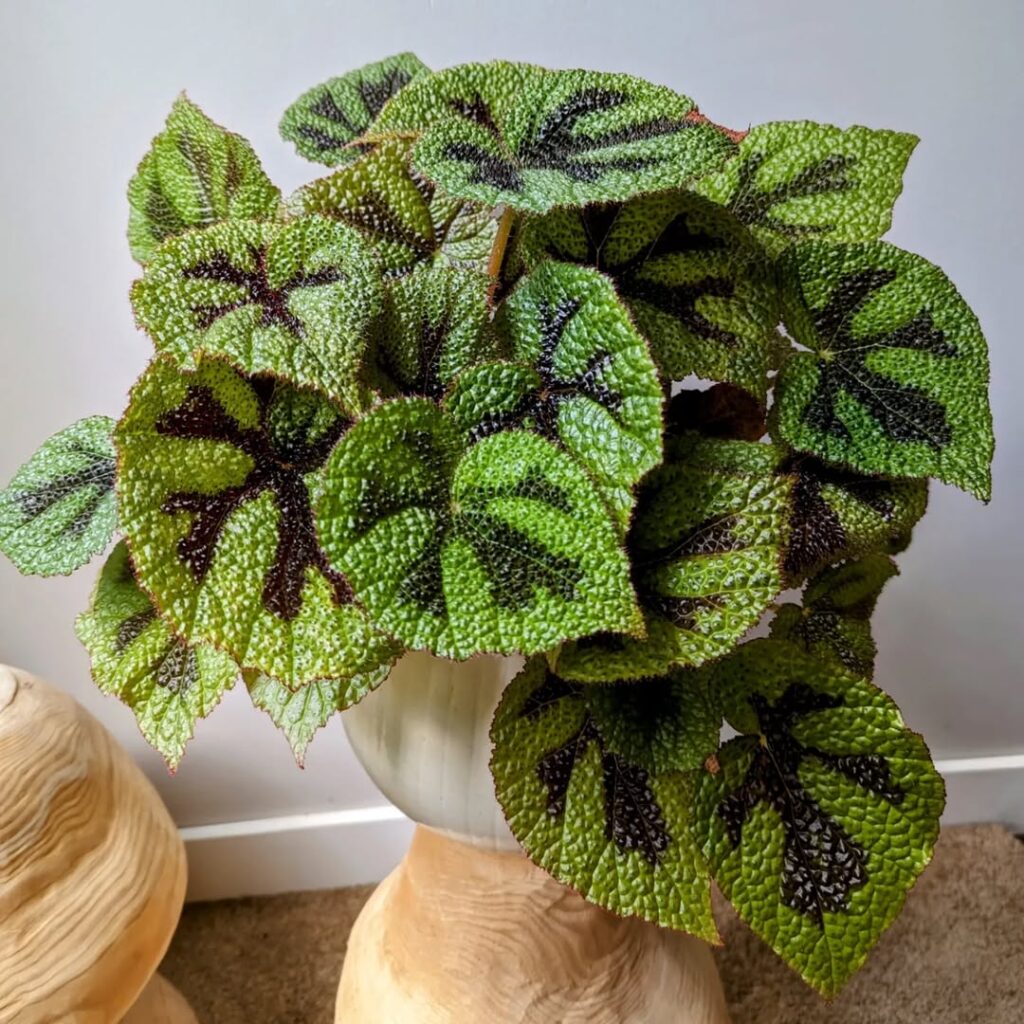
The Iron Cross Begonia (Begonia masoniana) is a striking rhizomatous begonia known for its distinctive dark brown to black cross-shaped marking in the center of each leaf, set against a textured, olive-green background. The leaves are deeply quilted with a slightly fuzzy texture, growing up to 8 inches wide, while the plant itself reaches about 12 inches in height. Though it produces small pink-white flowers in spring, the foliage remains the main attraction of this unique begonia variety.
- Light: Bright, indirect light; protect from direct sun
- Water: Keep soil consistently moist but not waterlogged; water when top inch of soil feels dry
- Humidity: High humidity (50-70%); use humidity tray or mist regularly
- Temperature: 65-75°F (18-24°C)
- Soil: Well-draining, rich potting mix with added peat moss
- Fertilizer: Feed monthly during growing season with balanced fertilizer
- Container: Use pots with drainage holes
- Air Circulation: Good airflow to prevent fungal issues
5. River Begonia’s Silver Swirls
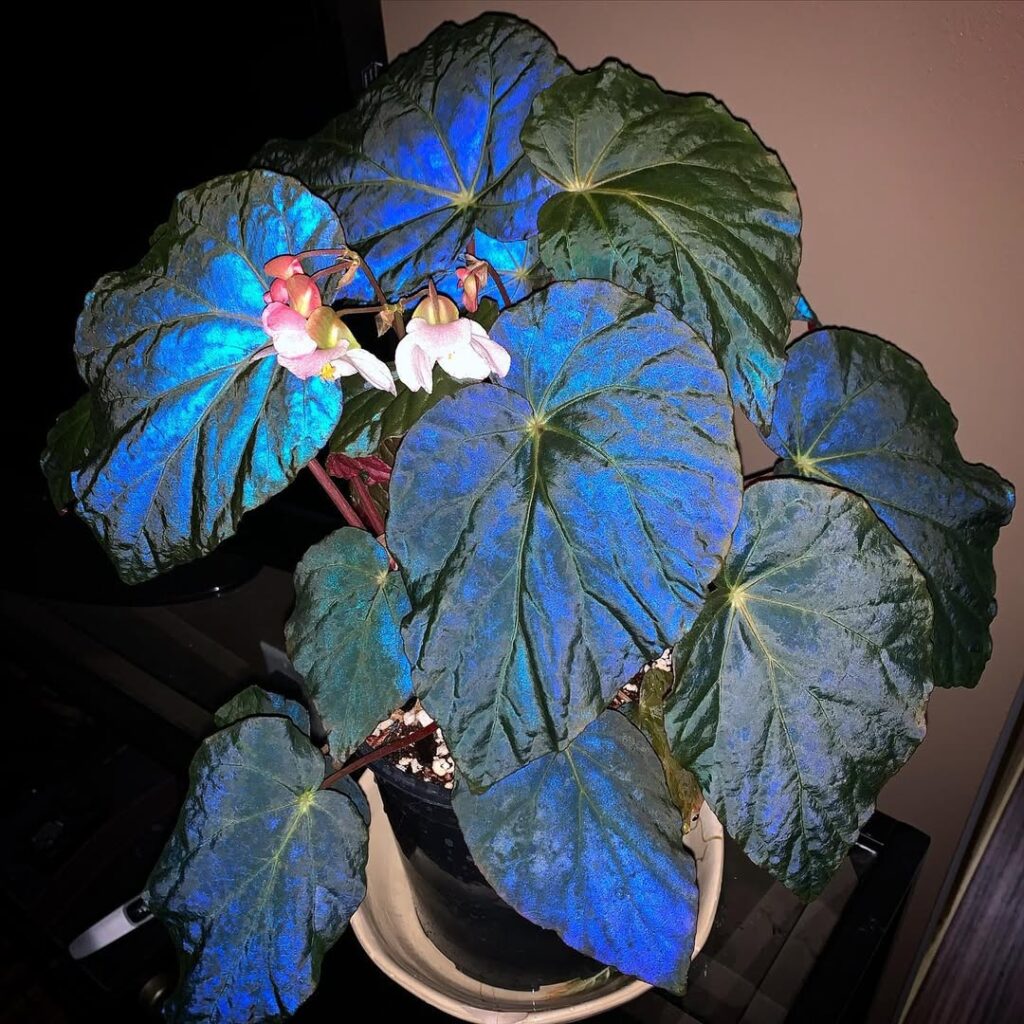
The River Begonia (Begonia pavonina) features spectacular foliage with iridescent silver swirls that seem to dance across its deep green leaves. When light hits the leaves at certain angles, they display an ethereal blue sheen due to specialized structures in their cell walls. These striking spiral patterns are most prominent on mature leaves and create a mesmerizing effect that makes this begonia variety particularly sought after by collectors.
- Light: Bright indirect light; protect from direct sun
- Water: Keep soil consistently moist but not waterlogged; water when top inch of soil feels dry
- Humidity: High humidity (60-80%); use pebble tray or humidifier
- Temperature: 65-75°F (18-24°C)
- Soil: Well-draining, rich potting mix with added peat moss and perlite
- Fertilizer: Monthly feeding during growing season with balanced liquid fertilizer
- Container: Pot with good drainage holes
- Additional Care: Avoid water on leaves to prevent fungal issues
6. Begonia ‘Fireworks’
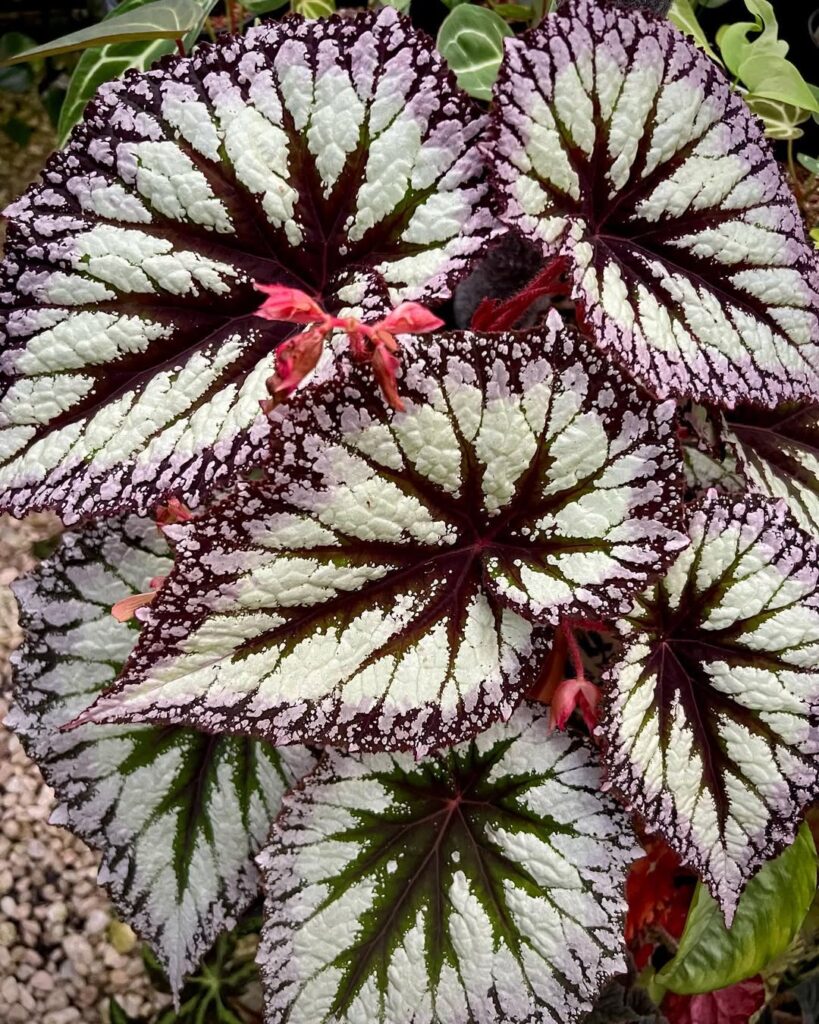
Begonia ‘Fireworks’ displays deep purple, metallic leaves with bright contrasting veins, creating a dramatic visual effect. This variety thrives in high humidity and indirect light, and though it occasionally blooms, its bold foliage remains its standout feature.
- Light: Bright, indirect light; protect from direct sun which can fade pink patterns
- Water: Keep soil consistently moist but not waterlogged; water when top inch feels dry
- Humidity: High humidity (50-70%); use pebble trays or humidifiers
- Soil: Well-draining, rich potting mix with added perlite
- Temperature: 65-75°F (18-24°C)
- Fertilizer: Monthly feeding with balanced liquid fertilizer during growing season
- Container: Pots with drainage holes to prevent root rot
- Growing Medium pH: Slightly acidic (6.0-6.5)
7. Begonia Lucerna
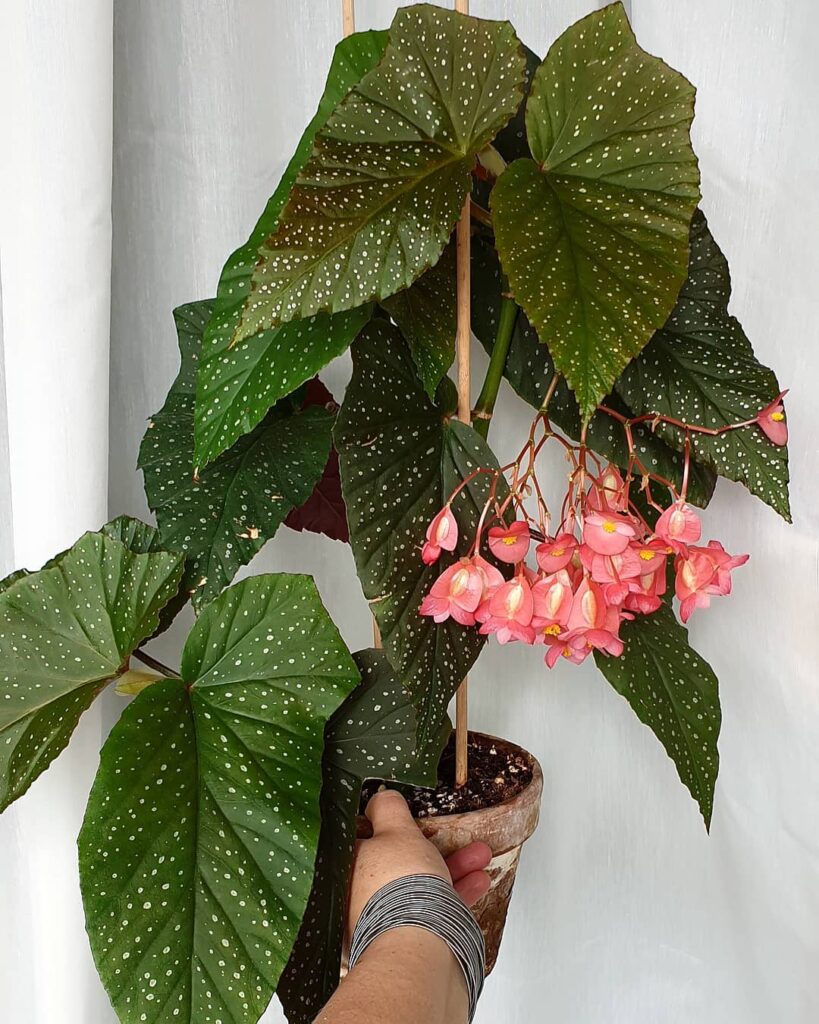
Begonia Lucerna has long, cane-like stems adorned with silvery-spotted leaves, adding depth to its bushy form. While it produces clusters of pink flowers, its patterned foliage is what makes it truly shine. It thrives in indirect sunlight with light watering, growing best with consistent humidity.
- Light: Bright, indirect light; protect from direct sunlight to prevent leaf burn
- Water: Keep soil consistently moist but not waterlogged; water when top inch of soil feels dry
- Soil: Well-draining, rich potting mix with high organic matter content
- Humidity: Minimum 50% humidity; benefits from regular misting
- Temperature: 65-75°F (18-24°C)
- Fertilizer: Feed monthly during growing season with balanced, water-soluble fertilizer
- Container: Use pots with drainage holes to prevent root rot
8. Beefsteak Begonia’s Red Underside
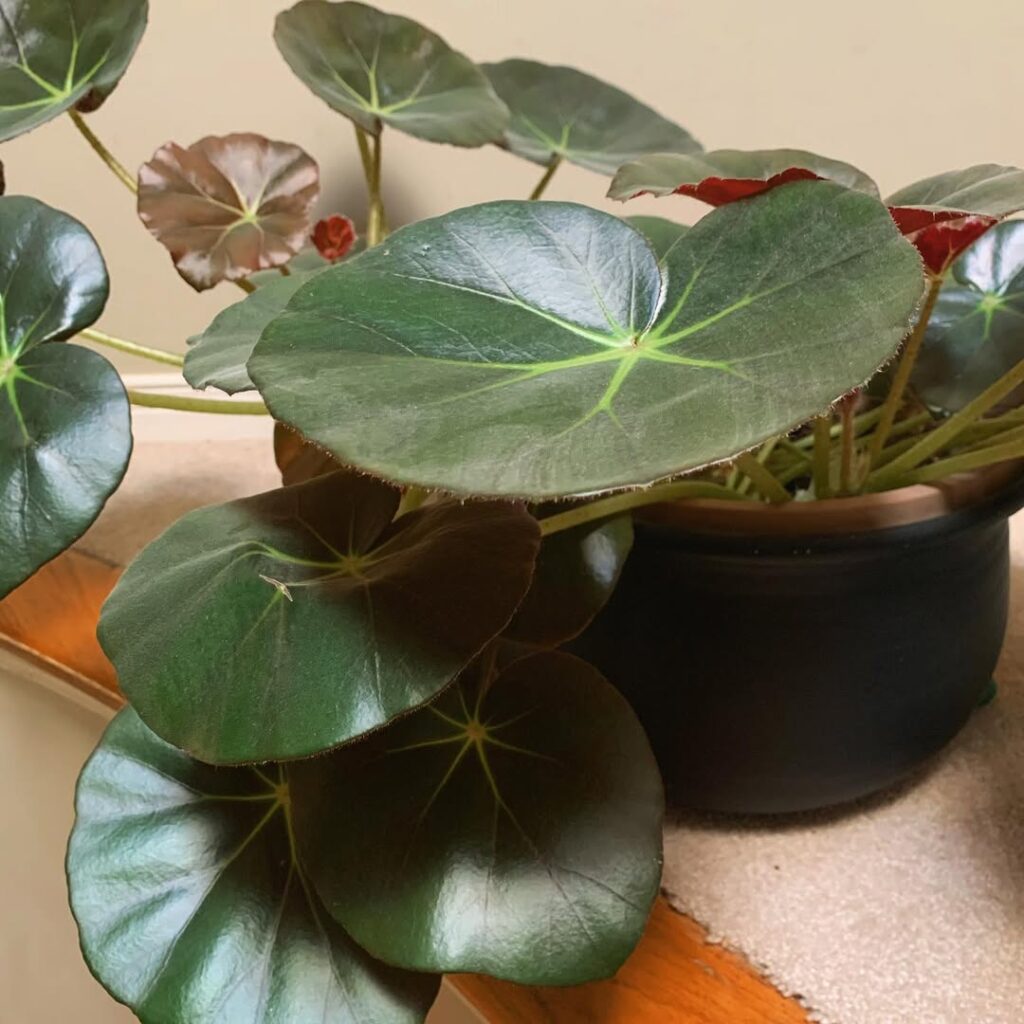
The Beefsteak Begonia (Begonia erythrophylla) is known for its distinctive red undersides, which create a striking contrast against its glossy, dark green upper leaf surface. These round, fleshy leaves can grow up to 8 inches in diameter and have a slightly puckered texture that resembles the surface of a beefsteak tomato. The red underside intensifies when the plant receives proper lighting, adding dramatic visual interest when the leaves move or curl.
- Light: Bright indirect light; avoid direct sunlight which can scorch leaves
- Water: Keep soil consistently moist but not waterlogged; water when top inch of soil feels dry
- Soil: Well-draining, peat-based potting mix
- Humidity: Prefers high humidity (50% or higher)
- Temperature: 65-75°F (18-24°C)
- Fertilizer: Feed monthly with balanced liquid fertilizer during growing season
- Potting: Use containers with drainage holes to prevent root rot
- Maintenance: Remove dead or yellowing leaves to maintain appearance and plant health
9. Begonia Soli-Mutata
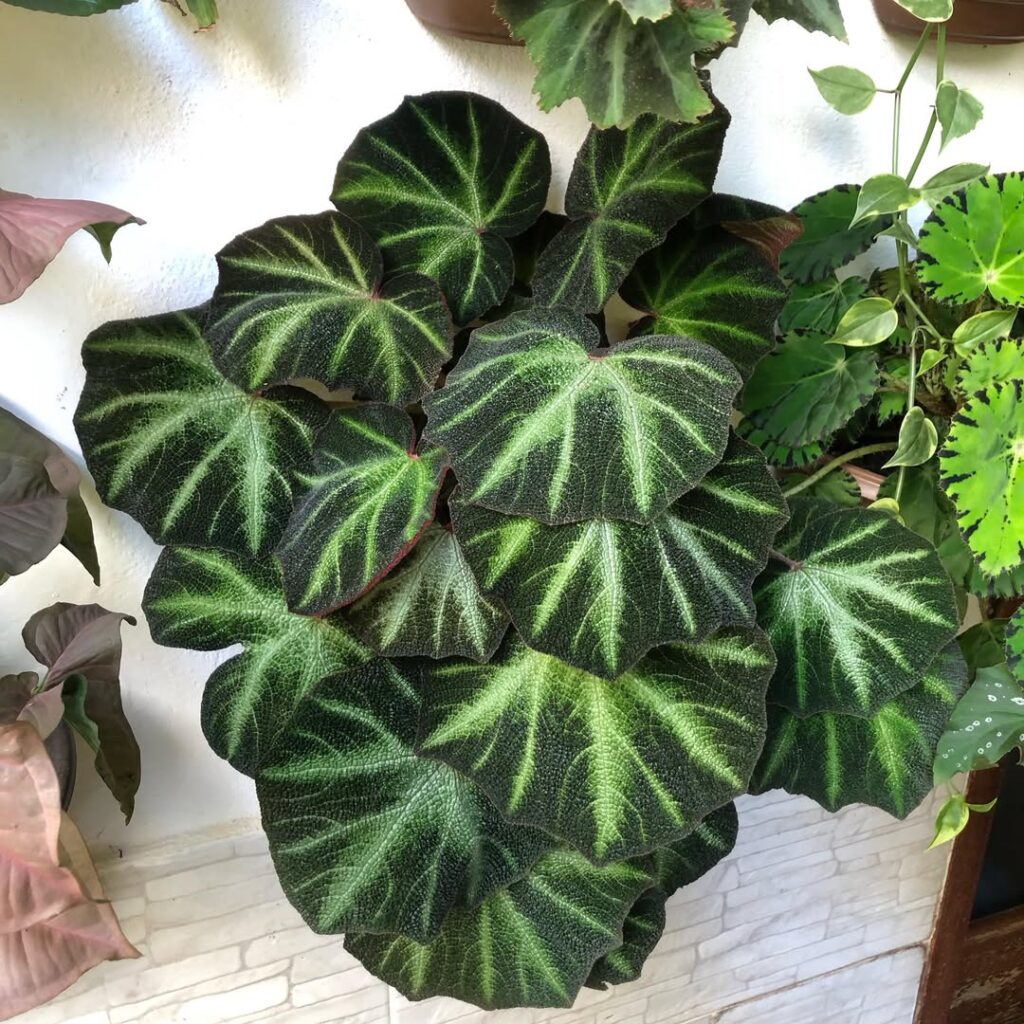
Begonia Soli-Mutata is famous for its color-shifting leaves, which change shades depending on light and temperature. This unique trait makes it one of the most fascinating begonias, perfect for adding visual interest to indoor spaces.
- Light: Bright, indirect light; protect from direct sun; can tolerate medium light conditions
- Water: Keep soil consistently moist but not waterlogged; water when top inch of soil feels dry
- Humidity: Requires high humidity (50-60%); use pebble tray or humidifier
- Soil: Well-draining, rich potting mix with added perlite
- Temperature: 65-75°F (18-24°C)
- Fertilizer: Feed monthly during growing season with balanced, water-soluble fertilizer
- Container: Use pot with drainage holes to prevent root rot
10. Begonia Bowerae
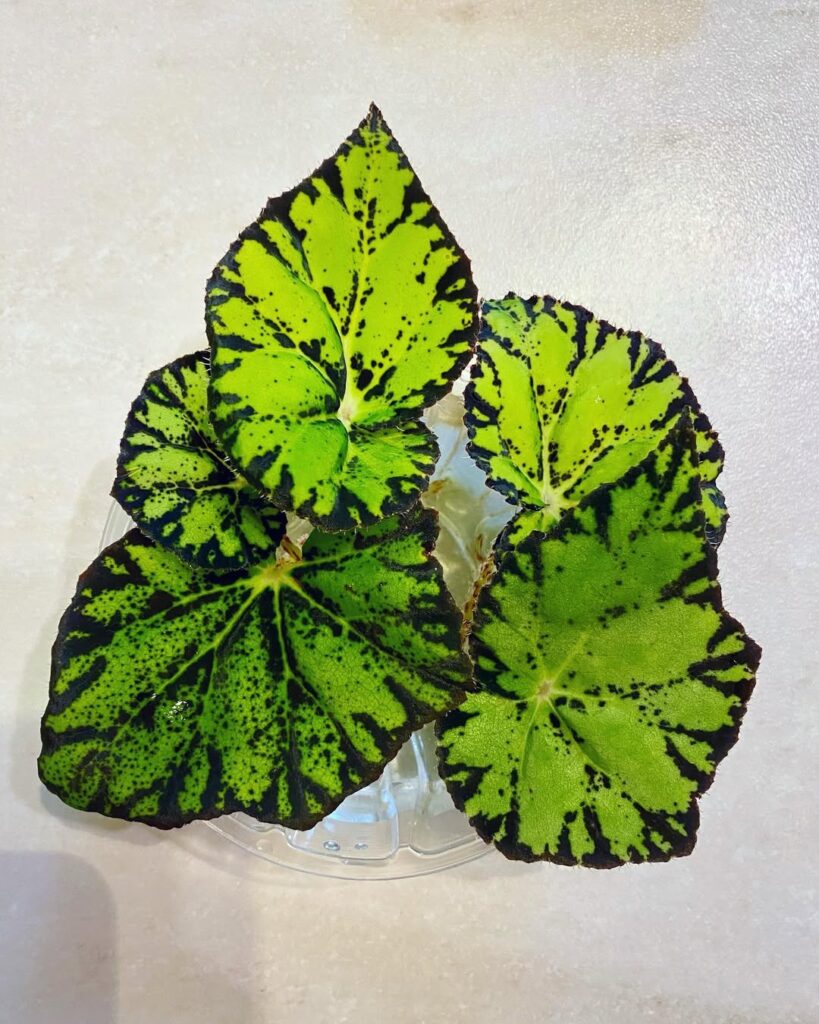
Begonia Bowerae, also called the Eyelash Begonia, has small, fuzzy leaves with dark edges, creating a delicate contrast.
- Light: Bright, indirect sunlight; can tolerate some direct morning sun but protect from harsh afternoon rays
- Water: Allow soil to dry between waterings; water less frequently in winter
- Soil: Well-draining potting mix with added perlite or orchid bark
- Humidity: Moderate to high humidity (50-60%)
- Temperature: 60-80°F (15-27°C)
- Fertilizer: Feed monthly during growing season with balanced houseplant fertilizer
- Container: Use pots with drainage holes to prevent root rot
11. Star Leaf Begonia
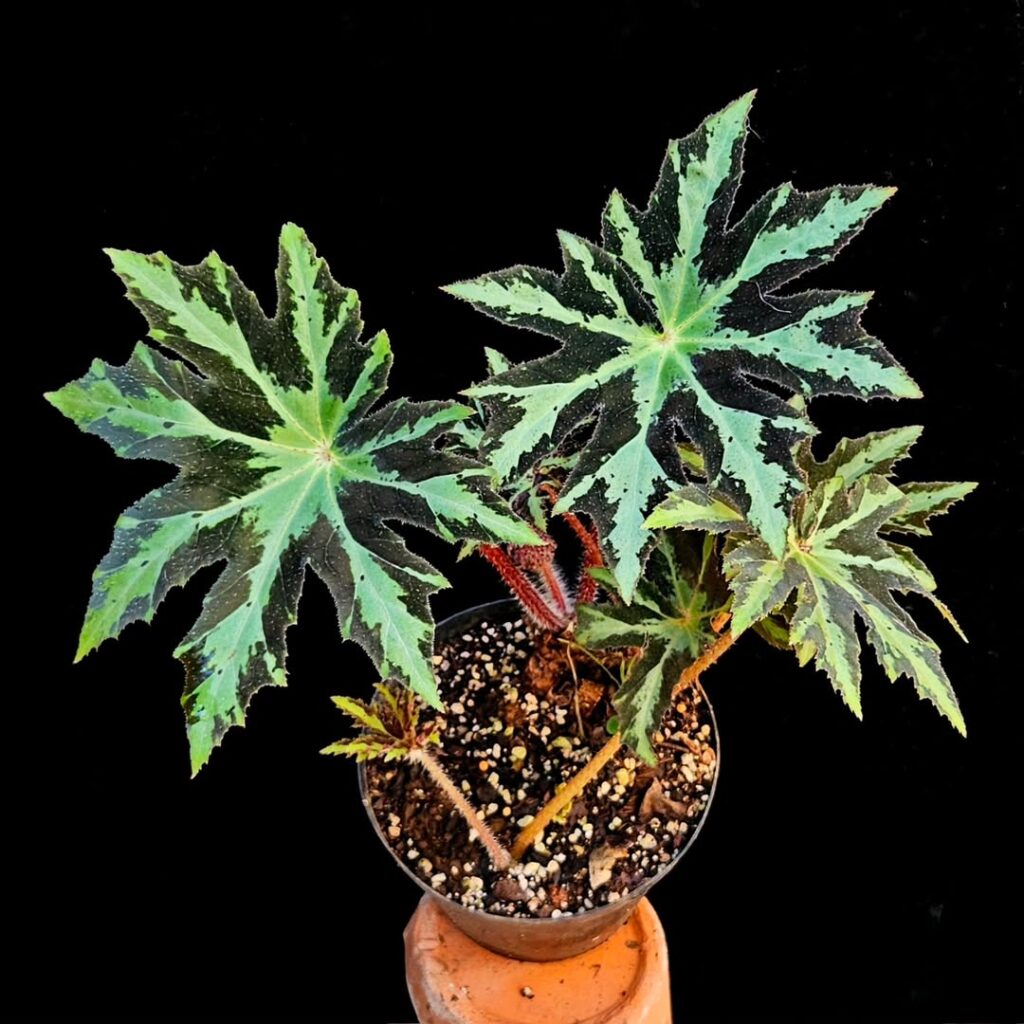
The Star Leaf Begonia (Begonia heracleifolia) features large, deeply lobed leaves with a star-like appearance and dramatic texturing. Its foliage can grow up to 12 inches across, displaying a dark green color on top and reddish-purple undersides. The leaves emerge from thick rhizomes and have distinct star-shaped patterns formed by prominent veining. During winter, it produces clusters of small pink or white flowers, though the plant is primarily grown for its striking foliage.
- Light: Bright, indirect light; protect from direct sun except for morning light
- Water: Keep soil consistently moist but not waterlogged; reduce watering in winter
- Soil: Well-draining, rich potting mix with high organic content
- Humidity: Requires high humidity levels of 60% or more
- Temperature: 65-75°F (18-24°C); protect from cold drafts
- Fertilizer: Feed monthly during growing season with balanced fertilizer
- Growing Zone: USDA zones 10-11, or as a houseplant
- Potting: Plant in containers with adequate drainage holes
12. Maple-Leaf Begonia’s Autumn Colors
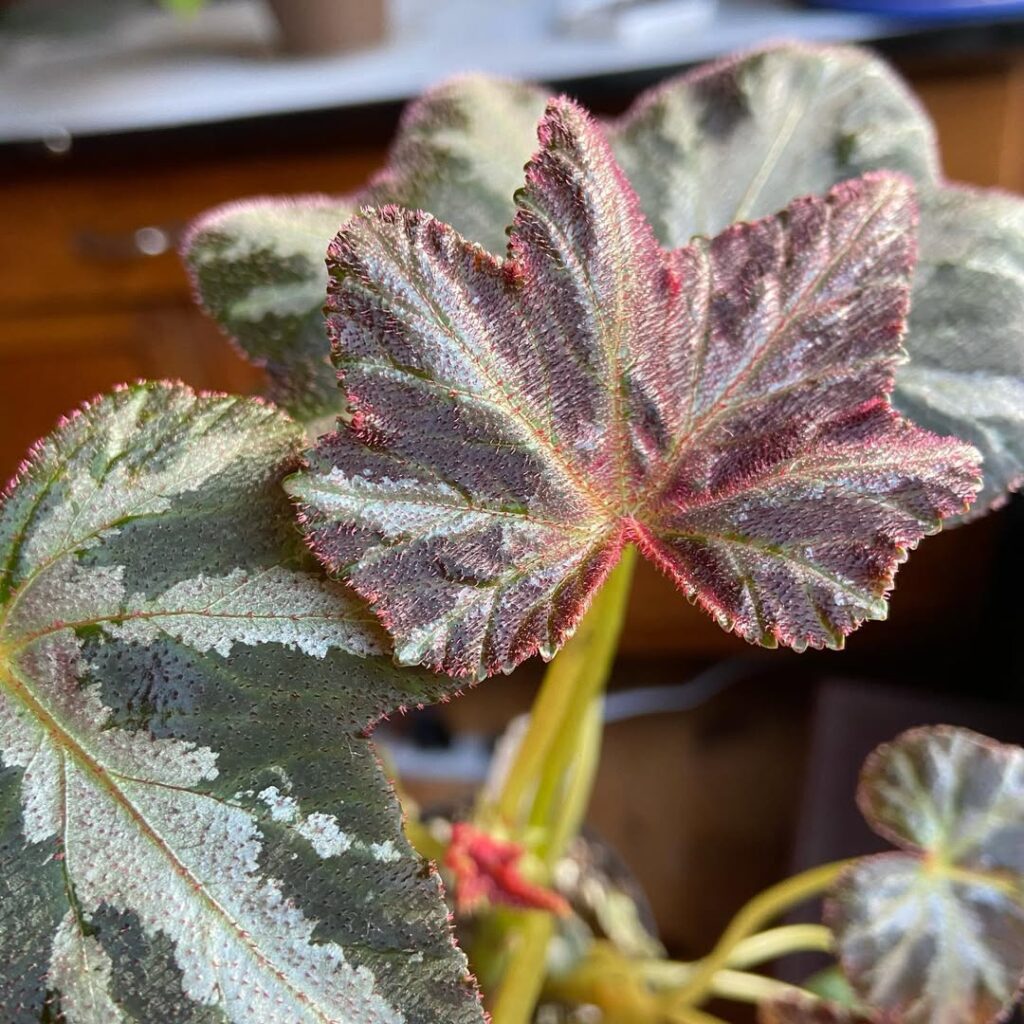
The Maple-Leaf Begonia (Begonia acerifolia) showcases spectacular autumn-like coloration year-round, with deeply lobed leaves reminiscent of maple tree foliage. Its leaves display rich shades of bronze, copper, and deep green, with prominent burgundy veining that creates striking patterns across the leaf surface. The undersides of the leaves feature a vibrant reddish-purple hue, adding to the plant’s ornamental appeal.
- Light: Bright, indirect light; protect from direct sunlight except for gentle morning sun
- Water: Keep soil consistently moist but not waterlogged; allow top inch of soil to dry between waterings
- Humidity: Requires high humidity (50-60%); use humidity tray or mist regularly
- Soil: Well-draining, peat-based potting mix rich in organic matter
- Temperature: Warm conditions between 65-75°F (18-24°C)
- Fertilizer: Feed monthly during growing season with balanced, water-soluble fertilizer
- Container: Use pots with drainage holes to prevent root rot
- pH: Slightly acidic soil (6.0-6.5)
13. Begonia Venosa

Begonia Venosa has thick, velvety leaves with a dusty green surface, making it an unusual but beautiful begonia. Unlike most begonias, it tolerates drier conditions and does well with occasional misting to maintain its fresh appearance.
- Light: Partial to full shade; morning sun tolerated
- Water: Allow soil to dry between waterings; water less frequently in winter
- Soil: Well-draining, humus-rich soil with pH 6.0-6.5
- Temperature: Hardy in USDA zones 6-9
- Humidity: Moderate to high humidity levels
- Fertilizer: Monthly feeding during growing season with balanced fertilizer
- Mulch: 2-3 inches of winter mulch for cold protection
- Spacing: Plant 12-18 inches apart to allow proper spread
14. Begonia Dregei
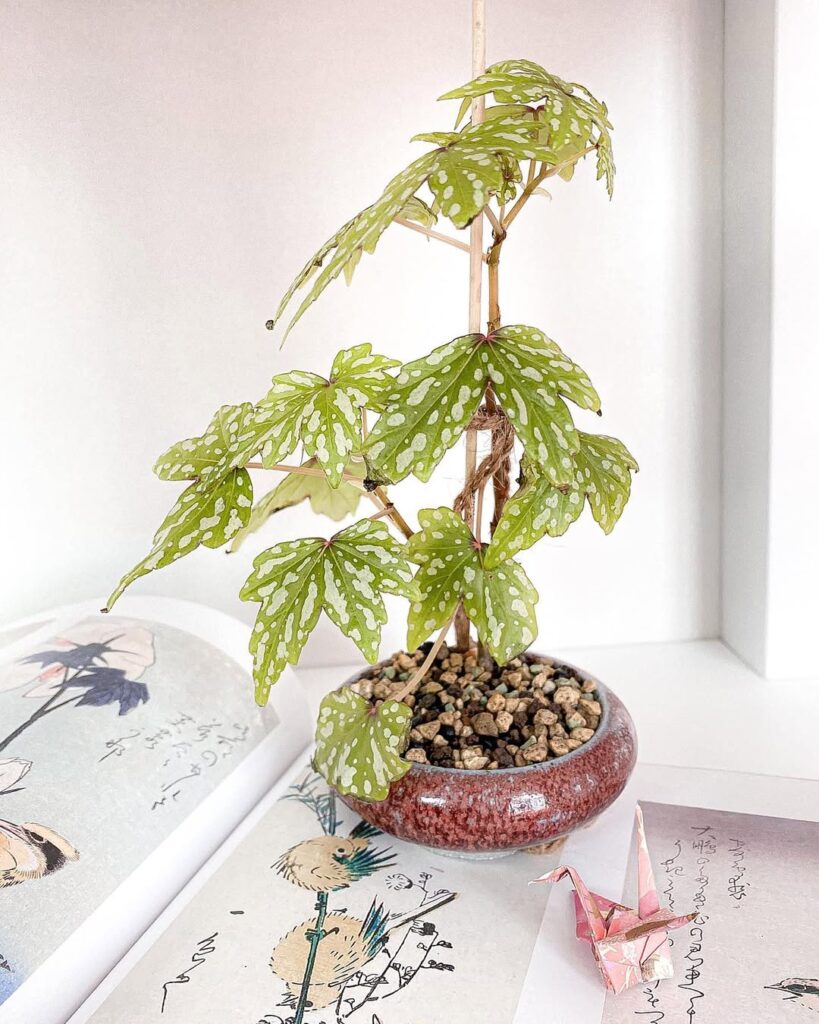
Begonia Dregei, also known as the Maple Leaf Begonia, showcases delicate, star-shaped leaves that give it a unique visual texture. Its tiny white flowers complement its light, airy foliage, making it a great choice for elegant indoor displays.
- Light: Bright indirect light; protect from direct afternoon sun; can tolerate partial shade
- Water: Keep soil consistently moist but not waterlogged; water when top inch of soil feels dry
- Soil: Well-draining, rich potting mix with high organic content
- Humidity: Prefers high humidity levels around 60%
- Temperature: 65-75°F (18-24°C); protect from cold drafts
- Fertilizer: Feed monthly during growing season with balanced liquid fertilizer
- Container: Use pots with drainage holes to prevent root rot
- Pruning: Remove spent flowers and yellowing leaves to encourage new growth
15. Begonia ‘Marmaduke’
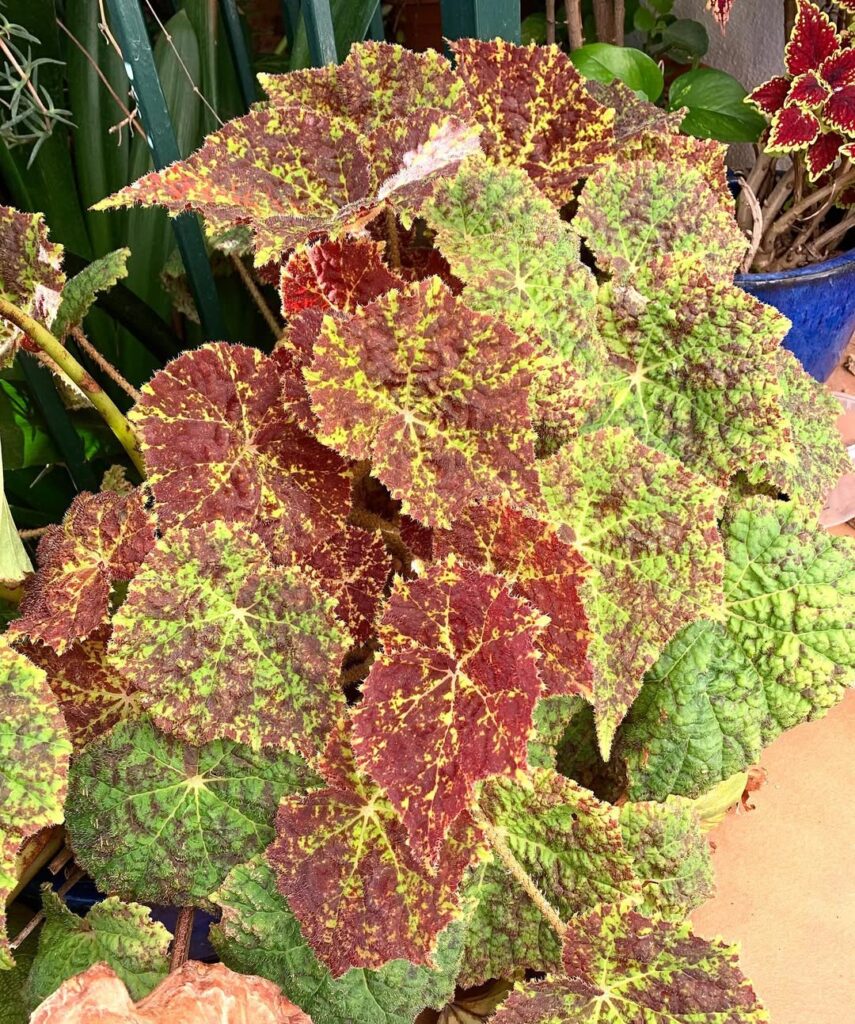
Begonia ‘Marmaduke’ is a rhizomatous begonia known for its large, asymmetrical leaves with golden-green tones and chocolate-colored speckles. Its fast-growing nature allows it to form a dense bush, making it a striking ornamental plant. The foliage exhibits a kaleidoscope of colors, ranging from deep green to maroon, adding to its visual appeal. While its delicate pink flowers are less prominent, they complement the bold leaf patterns beautifully.
- Light: Prefers bright, indirect light; avoid direct sun to prevent leaf burn.
- Humidity: Thrives in high humidity; mist leaves occasionally or use a humidifier.
- Watering: Keep soil consistently moist but not soggy; allow the top inch to dry between waterings.
- Soil: Requires well-draining, organic-rich soil; a mix of peat, perlite, and compost works well.
- Temperature: Best in warm indoor conditions, ideally between 65–75°F (18–24°C).
- Fertilization: Feed with diluted liquid fertilizer every 4–6 weeks during the growing season.
- Pruning: Trim leggy or damaged leaves to encourage bushy growth and maintain shape.
